Considering launching a 360 review process—or upgrading your current one? This can feel daunting, but it doesn’t have to.
We’re about to take an in-depth look at the 360 review process. We’ll walk you through best practices, pitfalls, and great questions to ask. And we’ll also share some success stories!
In this guide, we provide guidance for three groups of people:
- Reviewers: The people who provide reviews on their coworkers.
- Leaders and HR: The people who set up 360 reviews and communicate the feedback.
- Employees: The people being reviewed.
By the end of this guide, you’ll have in-depth knowledge of all elements of the process. You’ll then be able to approach the 360 review process with confidence.
Table of Contents
- Understanding 360 Reviews
- Best Practices for 360 Reviews
- Free 360 Reviews Template
- 360 Reviews Success Stories
Understanding 360 Reviews
Before administering a 360 review, understand its purpose clearly. Learn the key steps and benefits as well, so you can convey them to everyone involved.
What Exactly Are 360 Reviews?
A 360 review asks for input from multiple reviewers on an employee’s strengths and weaknesses. Reviewers typically include coworkers, a manager, direct reports, and anyone else who knows the employee’s work.
This feedback serves a strictly developmental purpose. Reviewers provide crucial input that shows coworkers where they need to grow. They also highlight strengths.
What 360 Reviews Are Not
Importantly, 360 reviews are not performance evaluations. Organizations should never use them to make decisions on promotion, termination, or salary.
Why? That would instill a spirit of unhealthy competition. And it would almost certainly cause deep-seated resentment. Employees would likely become suspicious of one another, wondering who gave feedback that harmed their career prospects.
In contrast, using the 360 review as a developmental tool promotes honesty. Employees don’t need to fear the consequences of giving candid feedback. When used well, the 360 review will only benefit each reviewee.
The 360 Review Process
How do 360 reviews work? We’ll examine the process step by step.
During 360 reviews, organizations administer a survey about a given employee’s strengths and weaknesses. They ask a wide range of people to complete it. The results provide a clear perspective of strengths and areas for growth.
Here are the key steps of the process:
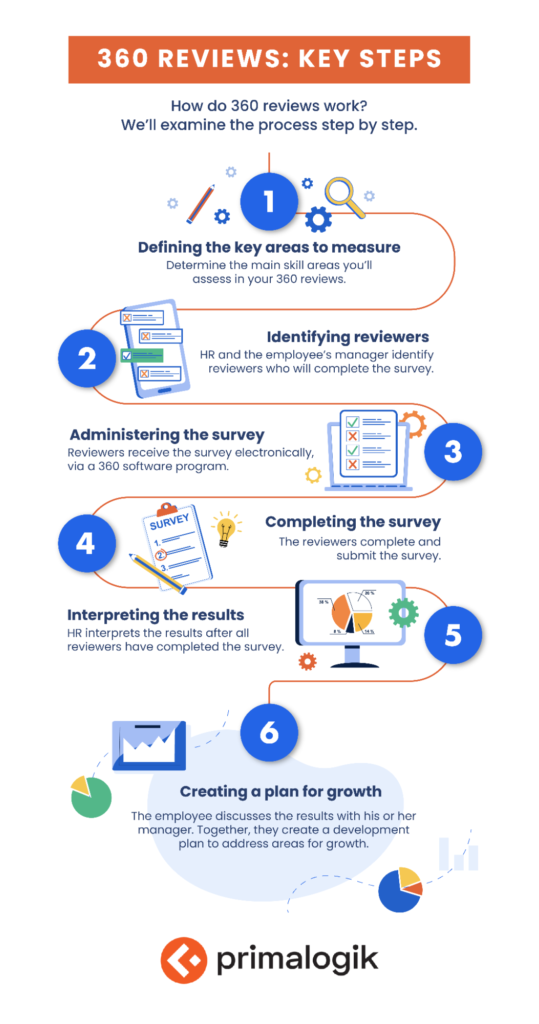
- Defining the key areas to measure
Determine the main skill areas you’ll assess in your 360 reviews. These may differ by role and level.
- Identifying reviewers
HR, and/or the employee’s manager, identifies reviewers who will complete the survey. The employee may also make suggestions.
- Administering the survey
Reviewers receive the survey. This can be done electronically, via a 360 software program.
- Completing the survey
The reviewers complete and submit the survey.
- Interpreting the results
HR interprets the results after all reviewers have completed the survey. Often a software program will help with this analysis.
- Creating a plan for growth
The employee discusses the results with his or her manager. Together, they create a development plan to address areas for growth.
The sixth step is crucial and must be prioritized. Without creating a plan for growth, all of this effort will go to waste.
Pros and Cons of 360 Reviews
A 360 review can bring many benefits. We’ll discuss them in detail, followed by potential pitfalls to avoid.
Benefits of 360 Reviews
What makes 360 reviews successful? Here are 6 key benefits.
- A 360 can highlight strengths that managers may not have noticed. Coworkers might point out a challenge the employee helped the team overcome, for instance.
- They help employees set goals for personal growth. This benefits both new and seasoned employees. During the onboarding process, 360 reviews can help new employees understand their progress.
- 360 reviews provide feedback an employee may not normally receive. For one thing, a 360 asks for feedback from direct reports. Ordinarily, direct reports may feel hesitant to give candid feedback. A 360 encourages their honest input, since it will support their manager’s growth.
- They convince people of the need for change, creating buy-in. “A 360-feedback process, when done right, greatly increases the chances that change will occur,” write Jack Zenger and Joseph Folkman in HBR. “For example, if others tell me that I’m rigid and don’t listen to a different viewpoint, the next time I’m in a discussion about a controversial topic, I’m more inclined to catch myself and listen.”
- A 360 can also help employees connect behaviour with outcomes, say Zenger and Folkman. Managers can see how direct reports’ engagement relates to their own leadership, for instance.
- 360 reviews can alert leaders to skills gaps in the organization. Then, you can work to fill them.
Do 360 reviews really work? According to Gallup, employees who receive this type of feedback improve their performance by 8–18%. Engagement can increase by 7–23%. And attrition can drop from 20–73%. In short, when done well, they can bring impressive results.
Potential Pitfalls of 360 Reviews
Where can 360 reviews go wrong? They can backfire for a few key reasons:
- The organization has a toxic workplace culture. Employees lack trust and may make mean-spirited comments on reviews. Such companies should make improving their culture first priority.
- Employees believe the review is a competition. This isn’t a zero-sum game, and it doesn’t directly determine performance. But if managers don’t make that clear, employees might believe otherwise.
- The review is so long that employees have trouble making time to complete it. So, a number of reviewers never turn it in, which skews results.
By following the best practices we’ll discuss, you’ll get valuable results from your 360 reviews.
Download Now: Free 360 Reviews Template [Get Your Copy]
Common 360 Review Variations
Often a 360 review focuses on performance in the current role. But some look into the future, tailoring the 360 to assess fit for an advanced position. Again, the 360 should not be used to directly make promotional decisions. However, it can be used to design a development plan geared toward a specific outcome.
Some organizations look at their succession plan before launching the process. Then, they use the 360 to evaluate employees’ readiness for advancement. Authors from the Center for Creative Leadership (CCL) explain that this helps identify the competencies these employees need. In turn, it allows organizations to fill the leadership talent gap.
Best Practices for 360 Reviews
Let’s now go over some best practices for 360 reviews. We’ll address what managers, leaders, and employees need to know.
Defining Skills to Measure
360 reviews are only valuable when they measure the right competencies. This will vary by role.
Fortunately, 360 survey software can help define which skills to measure.
Giving Feedback
How can you give valuable feedback during 360 reviews? Here are several guidelines to follow. Share them with all reviewers so you’ll get clear and valuable input.
- Focus on behaviour. Don’t share unfounded opinions—stick to the facts. Being objective will help the reviewee to accept your point of view. Otherwise, they’ll be more likely to push back.
- Be specific when giving feedback. Giving clear examples will help the reviewee understand your points. Plus, they’ll help you stay objective.
- Skip any questions that aren’t relevant. If you don’t have a meaningful opinion, don’t answer them.
Being too vague in feedback can also feel hurtful. Vague statements are often generalizations that can feel more harsh than clear, specific comments. They may even feel like an attack on character—which should always be avoided!
Examples of Good 360 Feedback
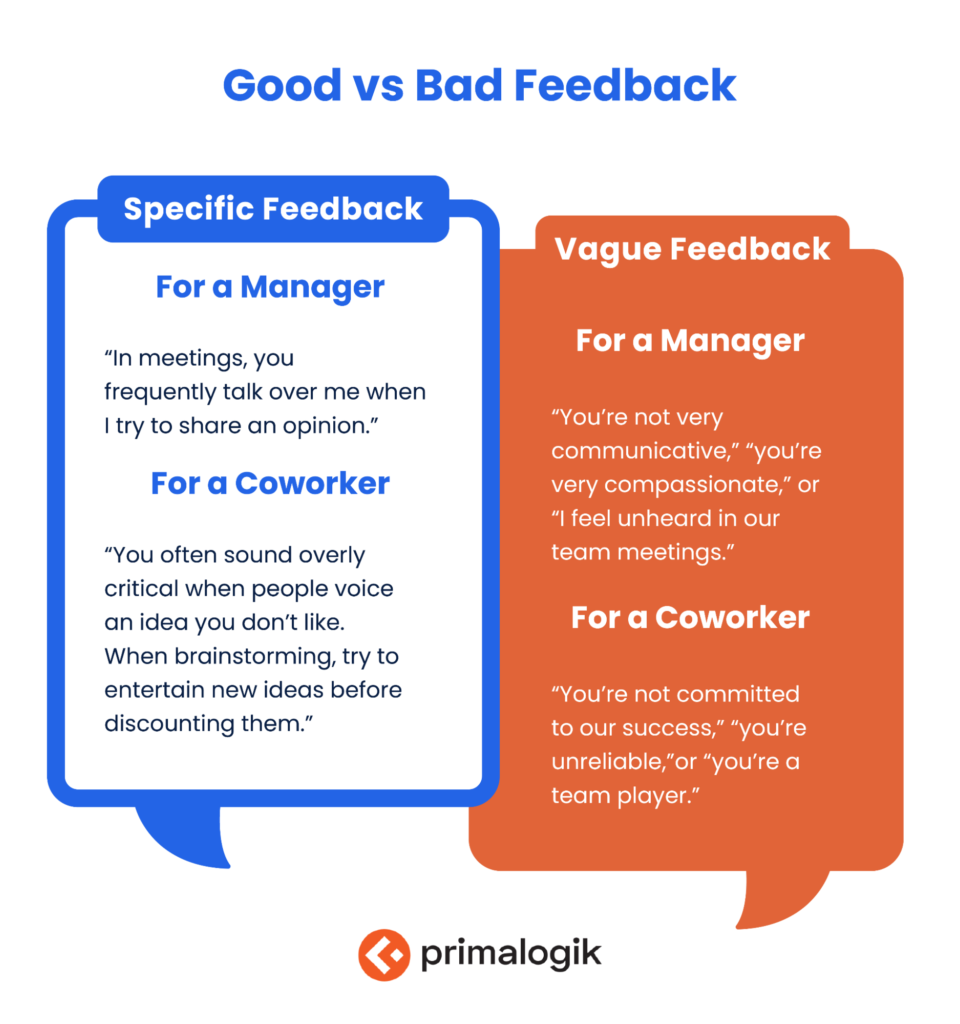
Here are some examples of helpful responses to open-ended questions.
Feedback for a Manager
- “I would like more feedback from you. More frequent one-on-ones would really help me understand my progress.”
- “You listen extremely well. I always feel heard when I talk with you. And you provide valuable guidance in overcoming challenges.”
- “In meetings, you frequently talk over me when I try to share an opinion.”
Feedback for a Coworker
- “You often sound overly critical when people voice an idea you don’t like. When brainstorming, try to entertain new ideas before discounting them.”
- “You always show up on time and prepared. You almost always complete tasks on time (or check in about schedule changes). I feel I can always rely on you.”
Examples of Bad 360 Feedback
Responses like the following are less concrete—and therefore, less helpful.
Feedback for a Manager
- “You’re not very communicative.”
- “You’re very compassionate.”
- “I feel unheard in our team meetings.”
Now, these opinions could still point to important areas for growth (or strengths). But such feedback would be strengthened by adding specific behaviours. Otherwise, the reviewee might feel demoralized, not knowing how to improve.
For instance, a reviewer might say, “When I have a critical concern, you seem too busy to talk to me.”
Feedback for a Coworker
- “You’re not committed to our success.”
- “You’re unreliable.”
- “You’re a team player.”
Without naming behaviours, feedback will feel very subjective. That’s important even when describing strengths. Employees need to know exactly what is working—and what is not!

Getting Great Feedback
Let’s examine how to get the best feedback for 360 reviews.
- Keep the length manageable. The survey should take about 20-30 minutes max to complete. That will help ensure all reviewers complete it in a timely manner.
- Avoid bias by sending the 360 survey to a balanced range of people. Don’t just send it to those with mainly positive or negative things to say.
- Explain the 360 review’s purpose and your policy on confidentiality. Also share guidelines for giving feedback. Go over these points in a team meeting and share them in writing.
- Follow up to make sure all reviewers have submitted their surveys. A good software program will send them automatic prompts. Plus, it will alert you when results are in.
Defining Roles
Conducting a 360 review begins with defining roles. Let’s review the main roles and key responsibilities for each one.
- Administrator: An HR manager who spearheads the review process.
- Raters: The people who complete the survey on a given employee.
- Reviewee: The person being assessed in the review.
- Manager: The reviewee’s manager, who helps the reviewee understand the results and create a development plan.
The reviewee’s manager often communicates the results to him or her. In some cases, HR may do so instead. But either way, the manager must understand the results and help design a plan for growth.
Selecting Participants
Let’s briefly review how to select the right reviewers. We recommend inviting 8 to 12 people to review each employee.
Who Should Participate in 360 Reviews?
The reviewers should include all of the following people:
- The reviewee’s manager
- Several of the reviewee’s peers
- The reviewee’s direct reports (if applicable)
Peers should include immediate team members who work closely with the reviewee. But colleagues on other teams can also be invited to participate. They may offer a valuable perspective as well. By including them, you can assess how the reviewee collaborates between groups.
All reviewers should have worked with the reviewee for at least several months. This ensures they have a well-rounded understanding of his or her work.
Who Should Determine the Participants?
The manager, or HR, should consider who to include. Invite colleagues who have worked with the reviewee in a range of contexts.
The reviewee should also suggest participants. Often reviewees have the best idea of who knows their work. They can suggest colleagues they’ve worked with closely on projects and tasks.
Who should not participate in 360 reviews? Anyone who hasn’t interacted substantially with the employee. For instance, say a colleague from another team has interacted only once or twice with the employee. This colleague may not have well-rounded feedback, so she should not be included.
Consider Whether to Opt for Anonymity
Most companies opt to make 360 feedback anonymous. After all, anonymity can ease any anxiety from sharing tough criticism. When employees review superiors, that’s particularly true.
But other organizations feel anonymity doesn’t fit their culture. For the sake of openness, trust, and transparency, they opt to leave names attached to reviews.
Neither way is inherently wrong. We tend to favor anonymity, but we understand why some organizations avoid it.
If you opt for anonymity, consider letting HR see respondents’ names. Then, HR can ask follow-up questions if needed.
Choosing the Right Software
The best 360 feedback tools streamline the process, saving you from handling tedious process elements. You can then focus on delivering and acting on the feedback.
The right program expertly highlights areas of strength and areas for growth. It gives you well-designed questions that provide the input you need. Primalogik has designed its customizable 360 software to provide the most relevant feedback to all your employees. Plus, you can customize your rating scale and ensure complete anonymity (if desired).
You can also compare reviewers’ rating styles to identify bias.
Customizing a survey allows you to incorporate your vision, mission, and values, notes John Behr in HBR. You’ll then get the feedback that’s most relevant to you.
Further, you can use Primalogik’s 360 software in combination with our performance management platform. This allows you to track progress after the review. You can also use our analytics to compare results from one review cycle to the next.
Using the Right Rating Scale
A good rating scale will give you nuanced input. “Yes/no” options obviously won’t provide that detailed level of feedback. Letting people select an option on a scale of 1–6 provides much stronger results.
You can use either numerical or descriptive scales. For instance, a descriptive scale could read, “Never,” “Occasionally,” “Sometimes,” “Often,” “Nearly Always,” and “Always.”
Asking the Right Questions
Questions on a 360 review typically focus on how a person contributes to a team. This includes how they relate to others, how they participate in team projects, and how reliable they are. Many questions also relate to emotional intelligence, which supports every aspect of work.
What subjects are not covered on a 360 review? Reviewers usually don’t directly address technical skill or project outcomes. They are better positioned to assess areas like interpersonal abilities.
Read on for 75 questions to ask during 360 reviews! Obviously, you don’t need to ask them all on a single survey. Rather, choose the ones that are most important to you.
Collaboration and Communication
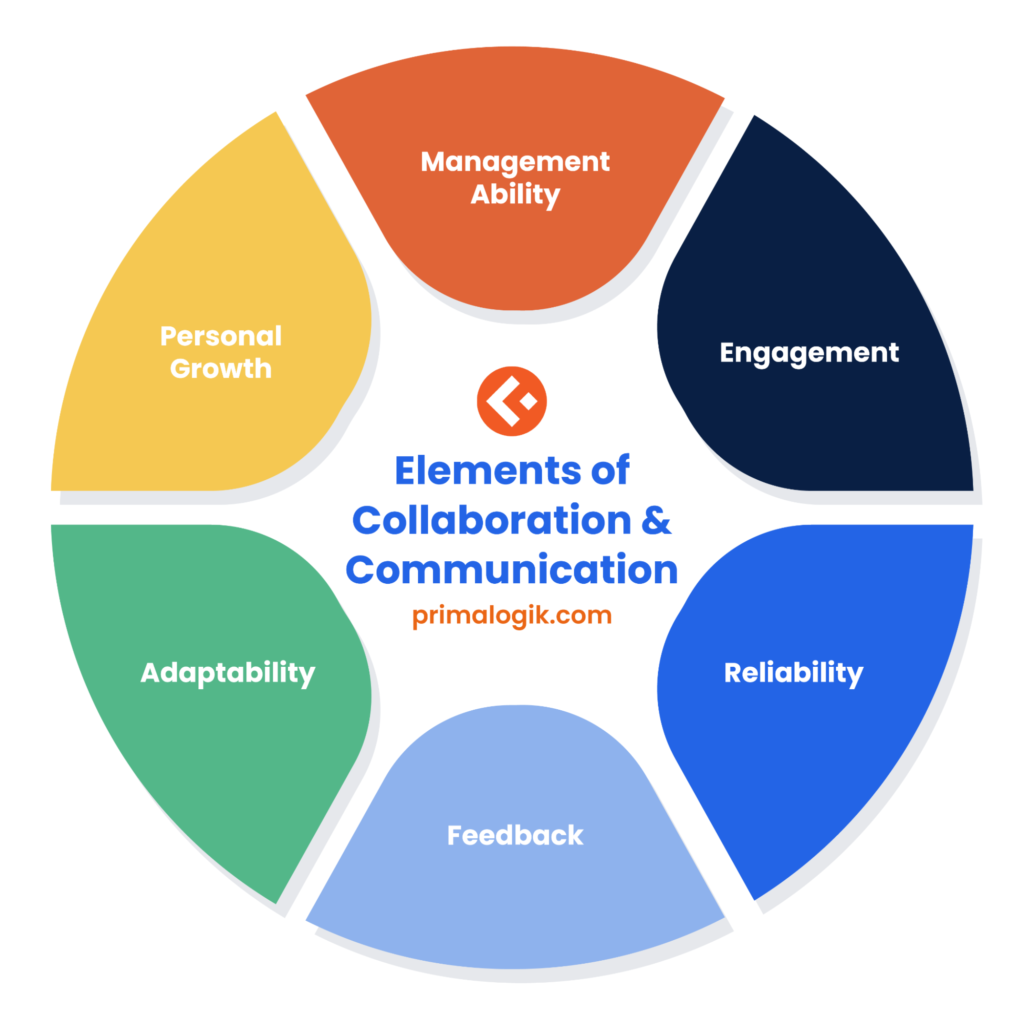
These questions assess ability to effectively cooperate and communicate.
Does the employee…
- Listen carefully to others?
- Ask for clarify when needed?
- Participate actively in discussions?
- Ask thoughtful questions?
- Explain ideas clearly?
- Check on whether others have understood his or her ideas?
- Communicate tactfully, showing sensitivity toward others?
- Take accountability for mistakes?
- Work to build strong relationships with coworkers?
- Show respect for others?
- Spearhead collaborations with coworkers?
- Resolve conflicts effectively?
- Write in a clear, concise manner?
Reliability
These questions reveal how dependable a person is.
Does the employee…
- Reach out frequently with project updates?
- Follow instructions well, adhering to an established plan?
- Complete tasks and projects on schedule?
- Show up to team meetings promptly?
- Work well under pressure?
- Manage stress effectively?
- Prepare adequately for meetings?
- Proactively work to solve problems?
- Check in with team members about unavoidable delays or changes?
- Produce a high quality of work?
- Address any issues in a timely manner?
- Pay attention to details?
Feedback
These questions address how well a person both gives and receives feedback.
Does the employee…
- Share criticism in a straightforward manner?
- Provide feedback in a timely manner?
- Show empathy when delivering feedback?
- Share gratitude with others when appropriate?
- Request feedback from others?
- Listen actively to feedback?
- Receive constructive criticism well?
- Integrate feedback into their behaviour?
Adaptability
These questions assess how well a person responds to change.
Does the employee…
- Work to embrace change when necessary?
- Look for more effective ways of handling things when needed?
- Set a strong example of how to courageously accept change?
- Welcome innovative solutions or ideas?
- Embrace process improvements, even if there is a learning curve?
- Look for new ways to approach a problem?
- Strive to learn from people with different backgrounds and perspectives?
- Listen to everyone’s ideas—not just those of leaders?
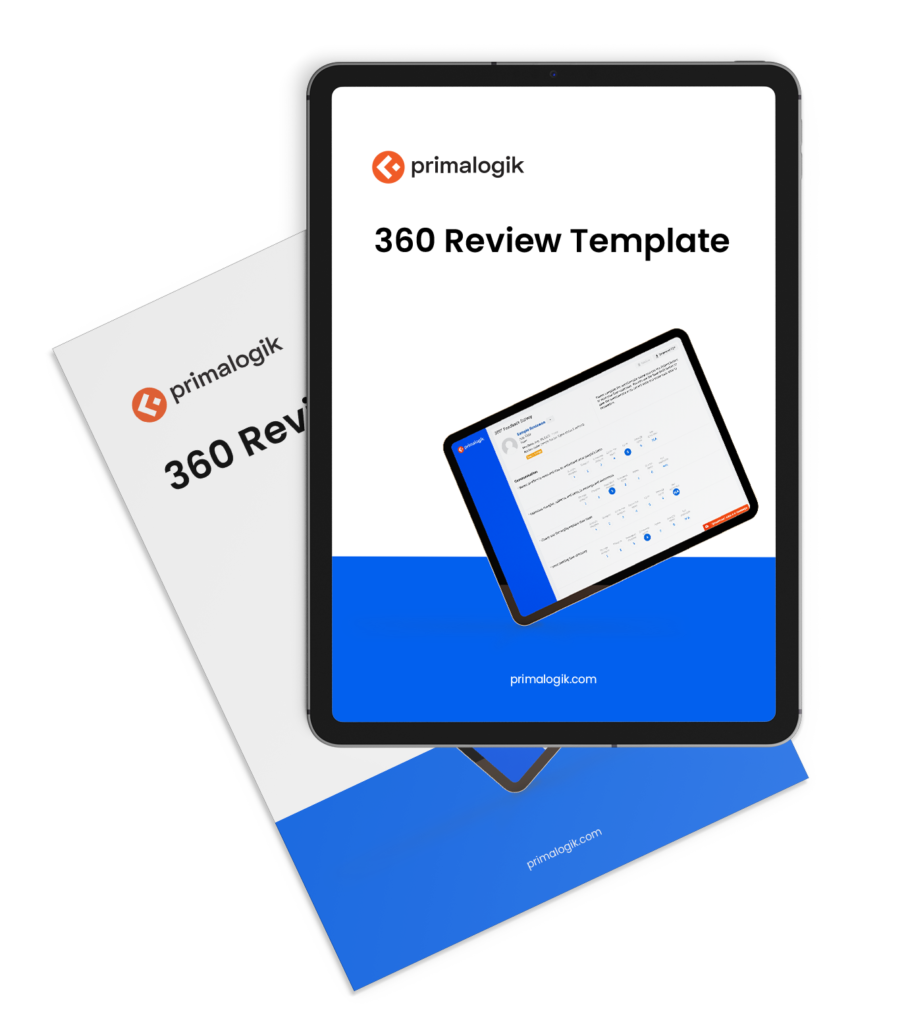
Download Now: Free 360 Reviews Template [Get Your Copy]
Engagement
These questions address the employee’s level of engagement and motivation.
Does the employee…
- Convey enthusiasm for his or her work?
- Stay focused on achieving goals?
- Strive to continuously improve performance?
- Share creative ideas?
- Strive to surpass expectations?
- Bring a high level of energy to projects and meetings?
- Share skills and expertise readily?
- Willingly tackle challenging tasks?
- Demonstrate strong awareness of organizational vision and mission?
Management Ability
These questions can be used for a manager. They are also useful for employees who act as project managers. Use them if they apply to the role (or a role the employee aspires toward).
Does the employee…
- Show concern for others’ wellbeing?
- Ask thoughtful questions to help others arrive at solutions?
- Maintain an approachable disposition?
- Guide team discussion in productive ways?
- Foster an inclusive workplace?
- Keep team projects on track?
- Motivate team members (and direct reports)?
- Share the necessary resources to allow team members to work effectively?
- Trust employees’ ability to carry out tasks and projects?
- Provide the right coaching to team members?
- Check in with team members (or direct reports) regularly?
- Encourage team members to share their strengths?
- Solicit everyone’s ideas and insights?
- Model organizational values?
Personal Growth
These questions examine whether a person takes a proactive approach to development.
Does the employee…
- Strive to learn from team members?
- Seek to learn from mentors?
- Work to develop abilities over time?
- Seek new opportunities to learn and grow?
- Network with others who can expand their knowledge?
- Use new knowledge for the benefit of the team?
- Strive to better understand roles that overlap with their own?
Do you feel certain questions are more important than others? The best 360 software can let you weigh rating questions differently. This helps prioritize key areas while gaining well-rounded input.
Also include a handful of open-ended questions. Here are several important ones:
- What are this person’s three greatest strengths? Number-one strength? (Provide examples if possible.)
- How does this person most need to improve? (Please share examples.)
- What would strengthen your relationship with this person?
- What else would you like to add?
A balanced mix of questions on these topics will lend well-rounded results. In other words, it will boost accuracy.
Preparing for 360 Reviews
Use this handy checklist to get ready for a 360 review. It’s based on points we’ve already discussed.
What to Do Leading Up to a 360 Review
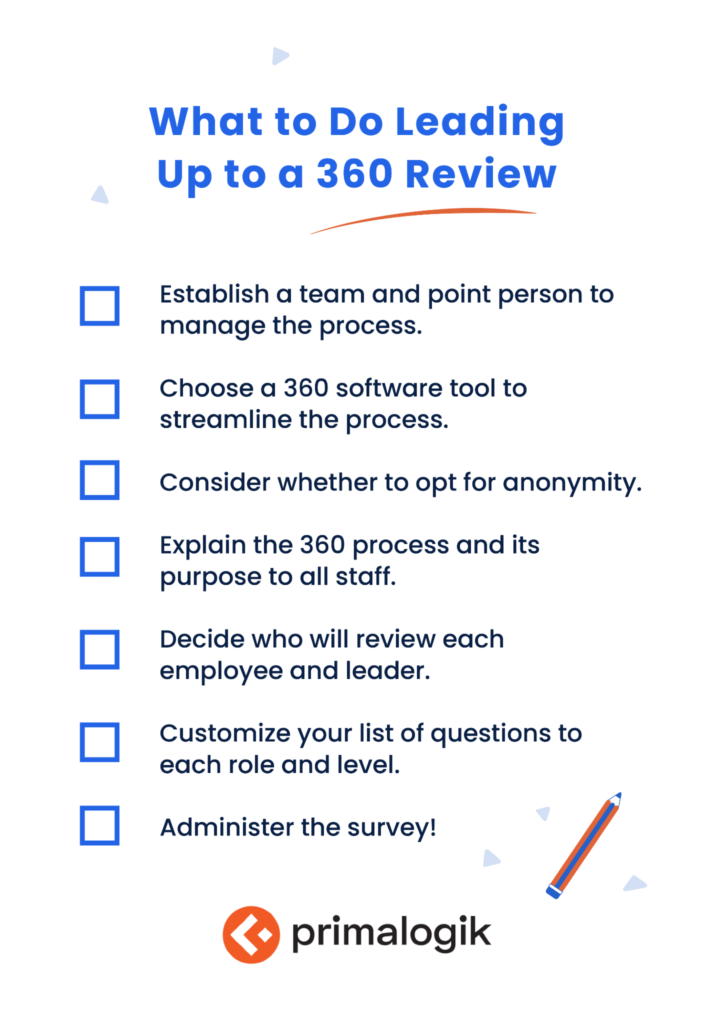
- Establish a team and point person to manage the process.
- Choose a 360 software tool to streamline the process.
- Consider whether to opt for anonymity.
- Explain the 360 process and its purpose to all staff.
- Decide who will review each employee and leader.
- Customize your list of questions to each role and level.
- Administer the survey!
Be aware that employees may have questions. So, make sure they know who to ask! Appoint an HR person on the 360 review team to field questions.
What to Do After 360 Reviews
Let’s explore what HR and the reviewee’s manager must do after the results come in.
Interpreting the Feedback
HR will typically handle this step. Here, you’ll interpret the data from all the surveys for each employee. 360 software can help with this.
Delivering Authentic Feedback
The manager often takes it from there. When delivering feedback, the manager should present both “positive” and “constructive” criticism. However, it’s important not to skew the balance of criticism that was presented. If it was mainly constructive, don’t downplay the tough feedback.
There might be a lot of input to take in. So, share a written outline of the feedback to structure this conversation. The employee can refer to it later to recap.
Designing a Development Plan
Next, the manager should create a customized development plan with the employee. Use the key feedback from the survey for guidance. Tailor the plan to the competencies required by the company and role, as Zenger and Folkman write.
Then, the manager should follow up during regular check-ins. Assess progress using performance management software and personal observations. Have conversations in weekly one-on-ones about progress.
Encourage leaders to share their own personal development plan with their teams. Summarizing their results and next steps will promote accountability and transparency.
Review the Reviewers
This final step will help ensure the integrity of your process. Compare reviewers’ rating styles (particularly managers’). Did they assess employees fairly? Good analytics can help you detect bias, so you can address it.
Below is a basic template for 360 reviews. You can send a customized version of it to reviewers. SHRM also offers a helpful 360-review template, geared toward assessing managers.
Free 360 Reviews Template
Free 360 Reviews Template
360 reviews are a powerful feedback tool for your people and business. But with so many potential questions to ask, don’t you wish you had a better idea of exactly how to implement your reviews? That’s why we created this easy-to-follow template. Download yours.
360 Reviews Success Stories
Countless companies have benefited from conducting 360 reviews. Here are just a few examples of companies that have used 360 survey software with great success.
Kinsa
Kinsa creates smart thermometers, leading the development of this technology. Through pulse surveys, they learned their employees wanted more in-depth feedback. So, they sought a tool that would let them implement 360 reviews. They also wanted a streamlined way to send pulse surveys and interpret all their data, as well as conduct performance reviews.
Now, they can more accurately track their progress not only as individuals, but as an organization. The dovetailed approach of using pulse surveys and 360 reviews has provided crucial insights on engagement and performance.
“Primalogik has saved us a ton of time and has given us a better understanding of where our employees excel the most,” says Lauren Davis, their VP of Marketing. “And our completion rate is consistently at 99% – 100%.”
Sensiba San Filippo
Sensiba San Filippo was initially looking for an efficient performance management solution, which it found in Primalogik. Their review cycle included several components, including a 360 review. So, it could be quite time-consuming, requiring up to 8 hours per employee.
Using our software solution allowed them to merge each of these components while providing reviewees with outstanding feedback.
They also loved how they could compare results from one cycle to the next. And the staff’s enthusiasm for 360 reviews skyrocketed. “We just used the 360° Feedback Surveys for the first review cycle to ease people into the system, but once we started getting comfortable with it everyone became enthusiastic about putting forward good information,” Alex Chan, Director of Development and Learning, told us.
Thumbtack
The CEO of Thumbtack wholeheartedly believes in the value of 360 reviews. In fact, he shares his results with the whole organization.
In Fast Company, he writes: “Without thinking too much about it, I opted to share my own review with, well, everyone. After I did, the entire leadership team followed my lead and also wanted to share theirs.”
So, they compiled their reviews into a single file, sending it to all employees. “In this simple act, we wanted to show that everyone, including me, has opportunities for growth and self-improvement.” By acknowledging their weaknesses, they made everyone feel safer naming their own. And it helped create a culture of striving toward personal growth—supported by 360 reviews.
As you skillfully implement 360 reviews, you’ll provide employees with input to shape their growth. And by following best practices, you’ll promote thoughtful and enthusiastic participation. Use 360 reviews periodically for best results, so employees can observe their progress over time.
Want to explore how Primalogik’s 360 reviews software can benefit your feedback process? Request a free 15-minute demo!




